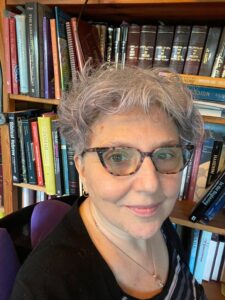 When I explore my own nature, or experience the sacred, most often I feel a deepening into darkness. Although dominating theologies create binaries, in which light is good and darkness is evil, when we recognize the multivalent nature of all that is, we see wave upon wave of dark and light.
When I explore my own nature, or experience the sacred, most often I feel a deepening into darkness. Although dominating theologies create binaries, in which light is good and darkness is evil, when we recognize the multivalent nature of all that is, we see wave upon wave of dark and light.
Some say they want to “embrace the dark” when they mean, embrace the grief, anger and suffering in the world, and be present with it, rather than denying, ignoring or hating it. But that is not the aspect of sacred dark that interests me most.
What interests me is how in darkness all separation dissolves into oneness. Darkness is depths, womb, soil where seeds sprout, soothing shade, night in which we grow and make long-term memory. Darkness is source, essence, innermost being, transcendence, nothingness, emptiness, mystery.
When we discount the power of darkness, we devalue all one might associate with it—dark skin, women, and the earth. Audre Lord wrote: “The woman’s place of power within each of us is neither white nor surface; it is dark, it is ancient, and it is deep.” (from “Poetry is not Luxury”, in Sister Outsider, 1984)
We need the holiness, and the liberating power, of deepening into the dark.
Jewish tradition evokes many forms of sacred darkness. Nighttime study brings a thread of loving-kindness into the world. Divine presence can be a sheltering shade. Revelations occur at caves. Torah was received in darkness, formed of black fire on white fire, and still the ink is black. The infinite source of all is imagined as a burning black coal or a deep spring. Before God said “Let there be light” there was already darkness, the darkness of wisdom and beyond. These images, and the texts that hold them, are openings that take us deeper into the sacred.
In Genesis, before God said “let there be light” there was “darkness over the face of the deep, the spirit/wind [ruach] of God brooding/hovering over the face of the water” (Gen.1:2). Biblical poetry is often structured with two parallel stitches in a verse. In this case “over the face of the deep” parallels “over the face of the water”, and “darkness” parallels “the spirit/wind of God”. There is something profoundly holy about this darkness, which Genesis tells us pre-existed what we think of as creation.
The creation story starts by saying “B’reishit bara Elohim et hashamayim v’et ha’aretz”, a strange grammatical structure saying something like “With a beginning of, God created the heavens and the earth.” The 4th-5th century CE midrashic collection, Genesis Rabbah (and subsequent Jewish tradition) interprets this “beginning” to be wisdom—Ḥokhmah. That is, with wisdom God created the heavens and the earth. In the proof text for this interpretation, Proverbs Chapter 8, Ḥokhmah is envisioned as a crone, standing at the crossroads. She says
It is Wisdom calling, Understanding raising her voice. She takes her stand at the topmost heights, by the wayside, at the crossroads…God created me at the beginning of His path (reishit darko).
Here we are given a vision of ancient dark female wisdom, assisting in the birthing of the world. The darkness in which all boundaries dissolve is a pathway that can take us beyond our individual selves into something bigger
The Zohar imagines the process of creation as a flowing forth from a deep spring or well.
In this image, the source is in the depths, and the flow goes up, (rather than the more common western image of source as up, with the flow going down.) Here, the closest we can imagine to the source of emanation of all creation is the dark point at the depths of the deepest spring.It is possible for us in our awareness to follow the flow of creation backwards to return to source. The deeper we go into the dark, into our own inner depths, and into the infinite depths, the closer we get to the source, to the essence.
The Zohar also teaches:
Every person who presents his request before the King should focus mind and will on the root of all roots, to draw blessings from the depth of the well, so that it will gush blessings from the spring of all. And what is that? The place from which the river issues and derives, as is written: A river issues from Eden…(Genesis 2:10)…This is called ‘out of the depths’—depth of all, depth of the well, springs issuing and flowing, blessing all. This is the beginning of drawing blessings from above and below. (Zohar II 63b, Daniel Matt translation)
The Zohar invites us to focus our awareness in the deepest depths, to the place from which creation emanated, the source of all blessing. And the more we can draw the flow of blessing from the deepest of the deep, the more the world will be filled with the presence of the sacred.
I invite you to listen to the following recording, to enter a short journey back through the creation story to be held in the dark waters, and hear what wisdom you may find there.

